The Best Product Market Fit Checklist for your B2B Marketing Strategy
To optimize your B2B Marketing Strategy, you need to know where you are. This product-market-fit checklist helps assess your progress.
Introduction to the basic b2b marketing strategy framework with tools to create and balance your SaaS go-to-market and marketing initiatives.
Get monthly GTM frameworks in your inbox.
Let's introduce the basic tools that I often use to start creating a T2D3 marketing plan from a CMO perspective. Managing the day-to-day operations of a marketing function has many different timelines. You need a long-term plan that carries you from one funding round to the next. Where do you need to get to for your series A? Then to series B? That timeline could drive a lot of your top strategic planning – and then you need to break it up into an annual budget with quarterly priorities. Then, of course, you must have the ability to track progress - monthly, weekly, and sometimes daily. This is a quick intro into managing the marketing function, and especially grounding it in that strategy.
In other blogs, I’ll dive deeper into tactical execution, which often includes things like OKRs, dashboards, scorecards, trackers, KPI metrics, etc. Here, we're really looking at an introduction into the strategy side, and how to get going with balancing strategy and execution, and setting you up for success to get sign-off, to get the right buy-in.
As a CMO, you need to strike a balance between a strategic perspective, and not being afraid to switch horses if something doesn't work. The world changes fast and assumptions will prove to be either true or false. A CMO also needs to have grit, confidence, and sometimes the courage to stick with a certain bet or focus area. Many things in marketing need a little bit of time to reach their potential. In marketing, and go-to-market in general, if you start and stop all the time, it's hard for things to get going, and that can be disastrous.
So, a CMO needs to have a very curious stance towards the unknown. Ideally, learn something new every day. A CMO should turn “I don’t know” into “What can I try? What can I try next? What can I test?”. You need to strike the balance between what I call strategic patience and tactical impatience.
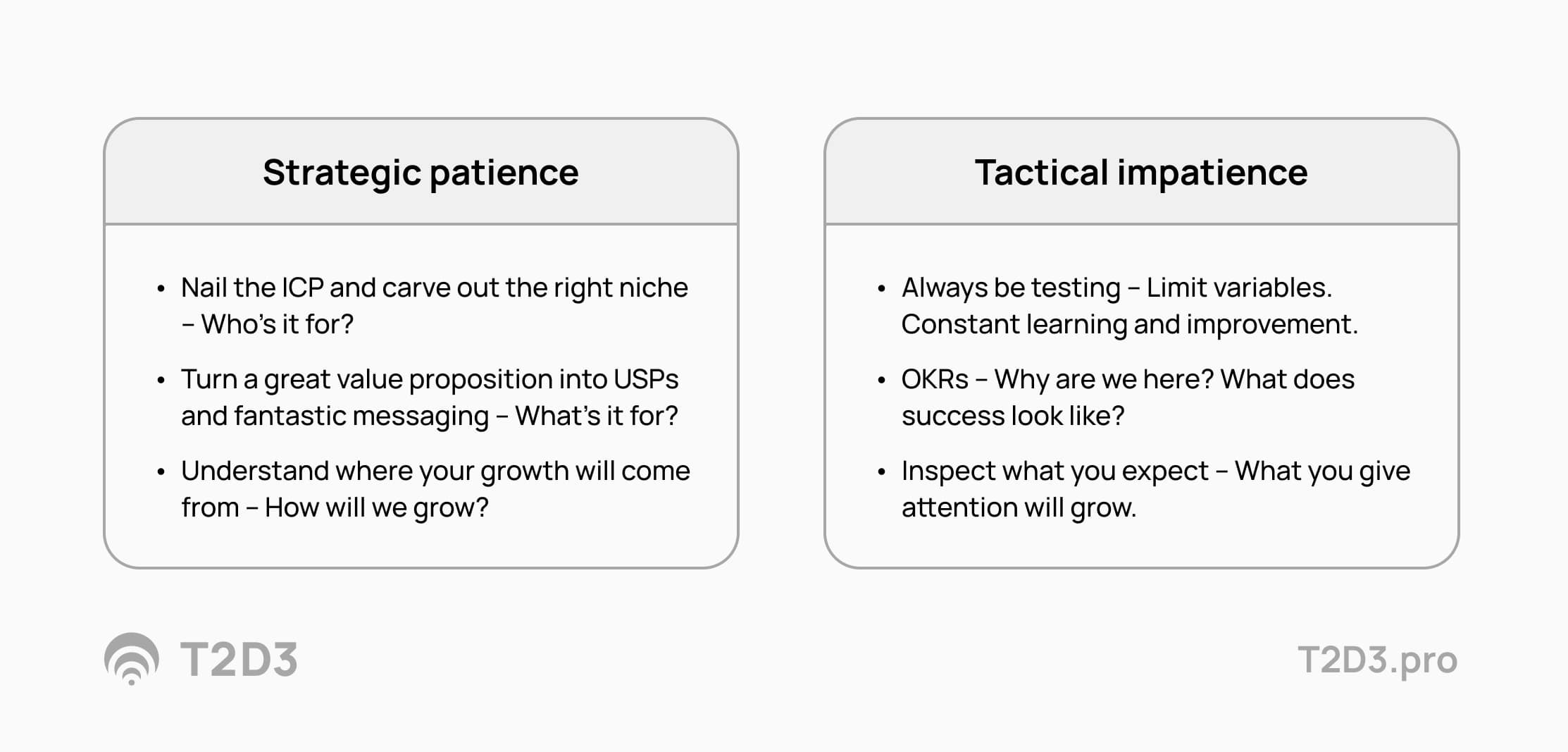
An example of strategic focus is to nail the ICP (ideal customer profile), and make sure that you're focused on the right part of the market (i.e. who is it for?). Or turning a great value proposition for that market segment into clear unique selling points, fantastic messaging (i.e., what's it for?). That is your positioning. Then you need to understand based on that ICP and that positioning, if you have a certain growth thesis, where are you basing it on? Where do you expect growth to come from?
Answers to those questions are really the premise of getting your strategy right. Then, the other part, tactical impatience, is about “always be testing”. Constantly learning and improving. You’re not going to get the results that you want unless you really focus your attention. Everything you give attention to grows. Inspect what you expect. The framework that I enjoy using for this are OKRs (objectives and key results). There are many other tool sets, but this is the one that we'll use in this deep dive series.
I want to step back a little bit and focus on the role of CMO, the marketing leader. As a leader of a modern marketing function in a B2B company, you really need to have a more strategic focus early. And specifically, when you're still getting to MVP, you are answering a lot of strategic questions.
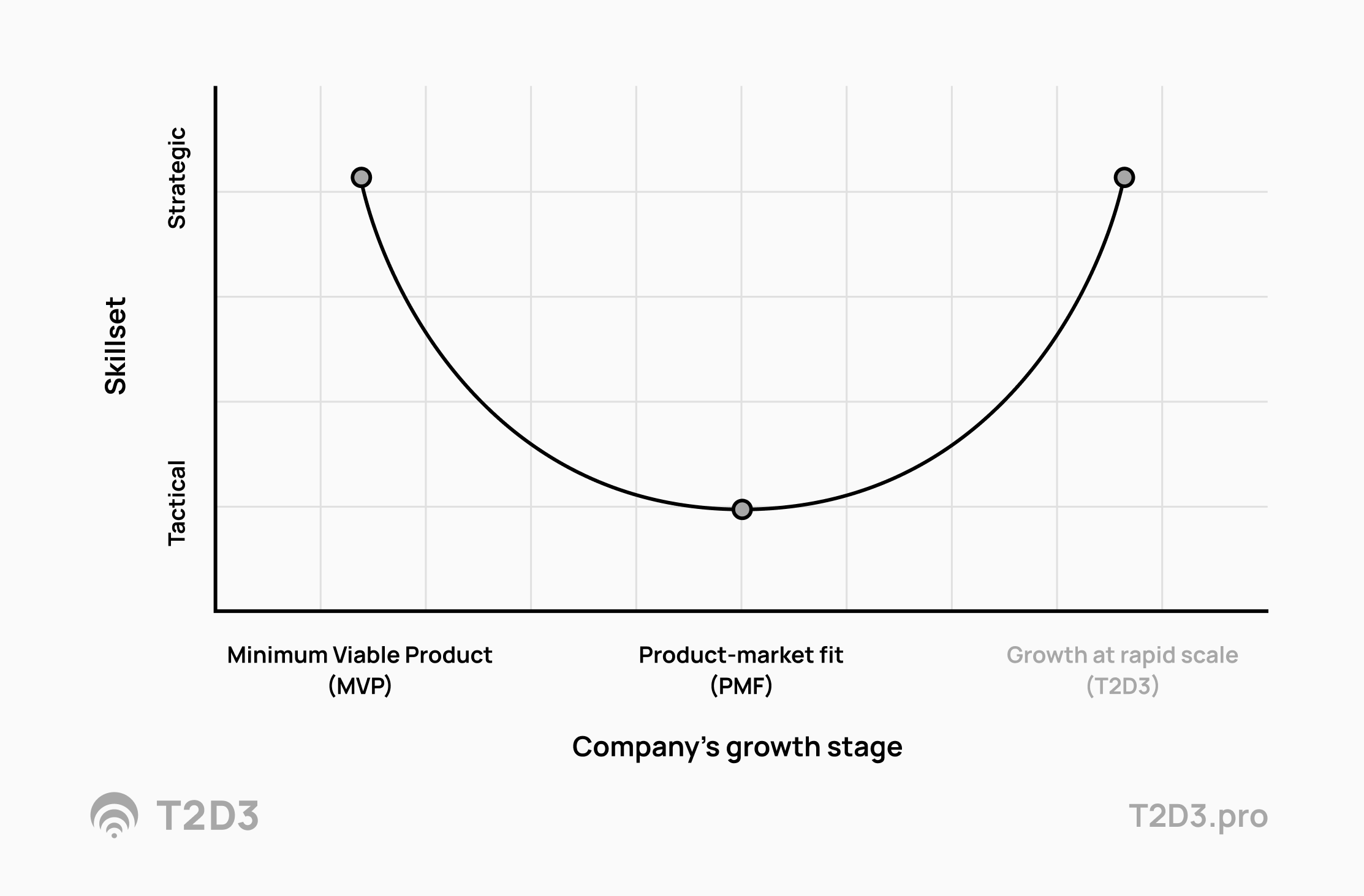
Those are very strategic questions where you need a CMO, or often the founder of a company, to be very involved at the strategic level to get a lot of those answers relatively early in your journey. But when you actually reach product-market fit (PMF), it's all about laser-focused execution. Even when you're just getting from MVP to PMF, there are a lot of real tactical things that you as a CMO need to focus on. It’s okay then to step back a little bit from the strategic vantage point. You need situational awareness - clearly understanding where you are in the T2D3 journey.
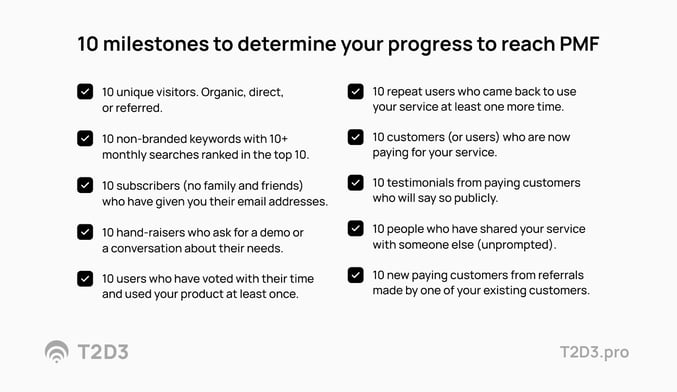
Check out this clip and more on the T2D3 YouTube
View the full lectures by signing up for the Masterclass program
Above is a helpful, quick cheat sheet and supporting video clip. When you are getting to product markets fit, you don't want to change your strategic direction all the time. You really want to focus on getting through the milestones, for example, on this list. These take time to do right, and extreme focus to get the content right, to get the messaging right, to use instant feedback to improve those. Fine tuning your ICP, driving down the friction in your funnel to make it easy for people to give you feedback, or to tell other people about your solution.
You need to celebrate every new customer, and their users, and try to learn from them. Get testimonials, get their feedback, help them be successful. That is how you can achieve your main goal, which is to get engaged advocates. That's really the goal of getting to product market fit. People who will use your product, who like using it, and then who will tell others about it. Which is a great definition for engaged advocates. And that's really what PMF is all about, right? To get people to pay for your solution, to stay with you, and then to tell others about it. Pay, stay, say.
When ready for T2D3 growth, when you need to drive exponential growth after achieving product market fit, is the time for the CMO to step back again. You need to put on a strategic hat to recruit and develop the right team able to do the execution across all these different factors that you need to hit on to drive T2D3 growth. You need to lead a larger team to execute all these multiple tactics in parallel - the five growth factors in the T2D3 formula.

As a CMO, you need to be the senior leader who does not do these things yourself, but can hire a diverse team of talent in all these areas. In addition, you need to be able to review the strategy from an ICP and positioning perspective, and perhaps redo some of that work that you did early on. When you go from PMF to T2D3, you may be ready to broaden the aperture, to expand the market segments that you're focused on.
To get going, you have to get answers to a multiple set of strategic questions:
You need to get alignment on your brand attributes, combining your identity and what you know about your audience into fantastic brand voice and brand visuals. Do you have assumptions that help you raise capital? This is why we need to have growth funding, because this is where we think we can grow. What is your growth plan based on? Do you have a specific go to market strategy in mind? Or is the market that you're in itself growing, and you're trying to capture that?
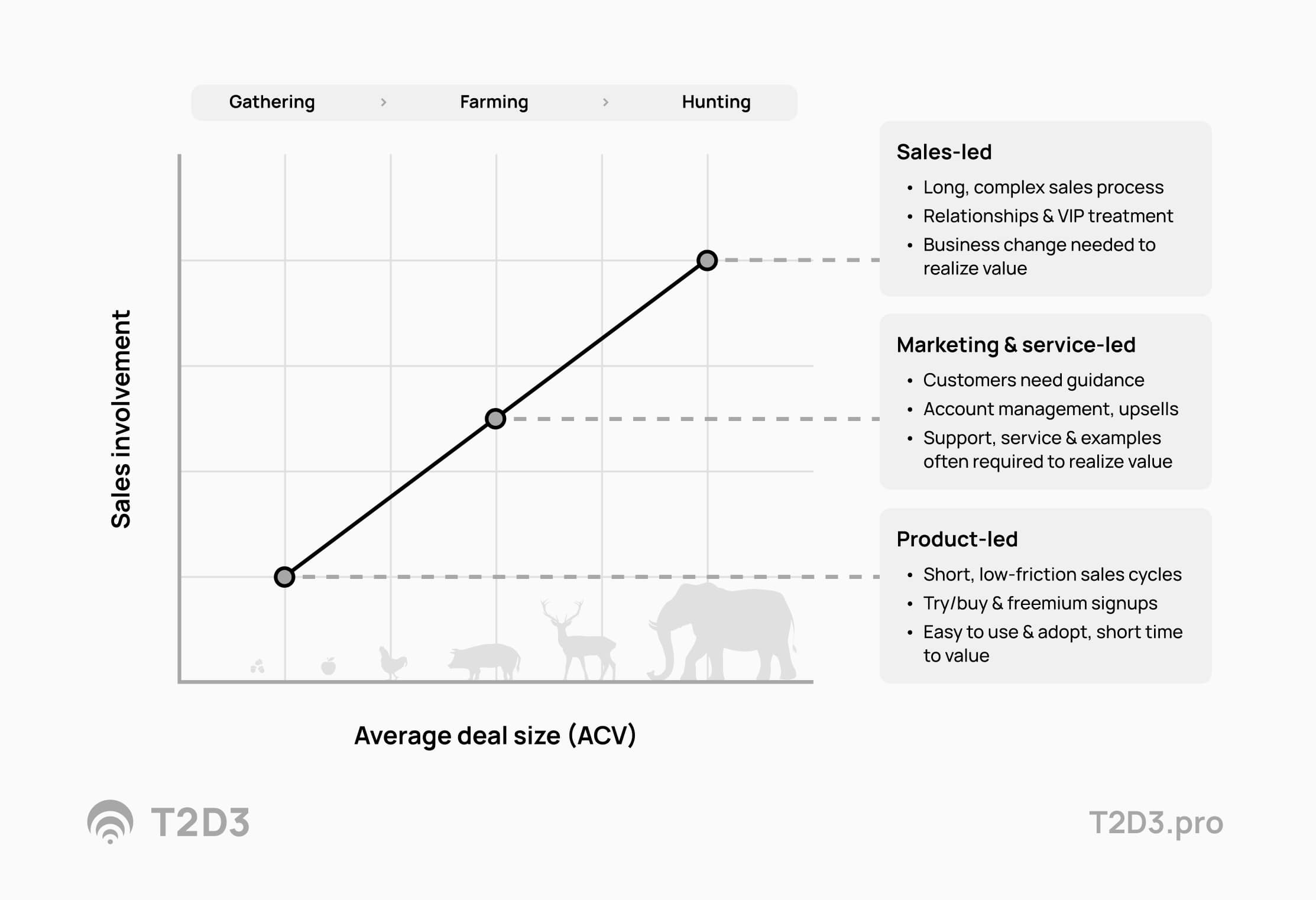
Before you think about the tactics, like content marketing and campaign execution, you need to understand what are the high level options that you have in front of you to go-to-market. There needs to be situational awareness, for example the size of your customers, that could determine some of your go-to-market options. Knowing well and sticking to your ICP means that certain types of go-to-market strategies are not available to you. Things like inbound versus outbound marketing. The cost of sales, and how you think about customer success, and whether you’re able to have SDR as part of your go-to-market machine?
When you start building your strategy, I love to run a marketing workshop with the leadership team, marketing team and even with stakeholders. This workshop focuses on the three things you need to have as a foundation:
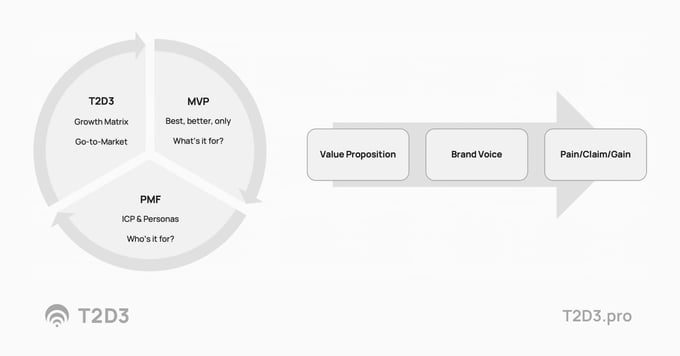
“Who’s it for” is really about ICP and personas. “What’s is for” is nailing down the solution you're providing. What is the unique selling point? What's the positioning? And then there is this whole more broader set of questions. How will we grow?
What's interesting is that you can, based on the journey that you're going through as a fast-growing B2B SaaS company, start at either of those points and have a real successful start. And this is really more of a rule of thumb than anything. You can actually start each of these three and do fine, but I have some thoughts on why you should start with one and then do the other two in a certain sequence given how mature your company is.
Let's say you're at MVP stage. You really don't know yet what is going to be the right ICP, the ideal customer profile. You're still testing that out, trying to get that early feedback from the market. I found that in those cases, the best start is basically talking about yourself:
Answering those questions is really where I start with relatively early stage companies. The exercise that we do is what we call the “best, better, only” exercise, and then do positioning work. Positioning vectors to really find those unique selling points and help you position and answer the question, what's it for?
Watch this clip and more on the T2D3 YouTube
If you started with MVP, then your next step would be to go talk about “who's it for?”. Based on our value prop, you focus on answering the following:
If you are at a state where you know who you are doing this for, you are maybe at product market fit, then this might be the best place to start your workshop.
The third step covers “how will we grow?”. More mature companies that have reached product market fit, that have invested more in growth already, may start the workshop here. In this phase, I have an exercise called the “Growth Matrix” that is very specific to nailing down where they expect growth to come from. As a team, they do a brainstorm, which includes things like the current market that you're focused on, potential future market or market segments that you could expand to, and what you can do with the current value proposition.
This exercise helps to improve and broaden the value proposition so that you can drive growth through that. From marketing execution to sales led growth, certain campaigns, initiatives, and optimizing your brand awareness. The growth matrix puts it into a framework to help you prioritize those, turn them into OKRs, but mostly get alignment as a leadership team.
All three of these foundational steps work together in sync and go round-and round. If you start with the T2D3 growth exercise, then you go back to the start of the wheel and you do the best, better only as the next step. And then you finish on what is the ideal customer profile. How do we go to market to the right personas with the right messaging, etc. So bottom line, when you do a growth strategy for a T2D3-type growth journey, you need to do all these three things. You need to answer, what's it for, who's it for and how will we go to market? And this gives you a little bit of an extra set of thoughts to where you start the work to get off to a running start.
After answering the three main questions in the workshop - which can take a day, or maybe half a day, depending on the size of your company, you are ready to build the next three foundational pieces:
These three parts are more linear. I always do them in this sequence. First is the value proposition, which is a combination of the who’s it for and what’s it for answers. The pillars of your value prop, sometimes mapped already to personas and ICPs, details the reasons to believe and is the positioning framework that clearly says how you will stand out versus the alternatives, versus competitors, and versus other things that the customers could do instead of buying your solution.
The second foundation is brand voice. This is a great area for the leadership team to collaborate. I like to use an exercise where I have hundreds of words that we whittle down to only five words. Words that really define and anchor your brand. When choosing these brand words, try to answer:
There are a lot of words that in themselves are all positive, but can really make the difference in how you write the copy for your website, how you show up in an email campaign, how you present yourself at a trade show or even in your company logo, colors, etc. So that's really an important exercise. It also helps with some leadership team building and alignment. Doing great messaging and great visual branding often is helped by doing this exercise very well.
Finally, I love to end with what I call the pain, claim, gain exercise. It veers a little bit into content marketing, into messaging, to cement what we've done so far. You're not going to go into a lot of technical detail, but a strategy for the full customer journey.
What do we think are the questions that people ask as they go through awareness, consideration, conversion? Awareness is often about pain. Why should someone change? The consideration part is about your claims. What is it that you do special that makes them need you? So the first question that needs an answer is why change, and then why you?
Then the last part, the conversion, is all about why now? And what do they tend to gain? What would they miss out on if they don't convert? And for this last piece of the workshop, I like to go very concrete on SEO.
Doing this brainstorm about potential lead magnets, promises or guarantees that we are comfortable providing as part of our content or offers, are great litmus tests for all the work you've done before on branding, positioning, segmentation, etc. And your growth assumptions.
When you do a workshop like this, there are a couple more things to prepare, some tips. It’s important to base your value proposition work on some good competitive research that you do before the workshop. This helps you lead a positioning discussion, a best, better, only discussion. You need data to challenge things and to keep the conversation going.
I talked a little bit about pain, claim, gain. It really helps to make the persona as real, for example. If you think of what are the real pain points that people have, their fears, their dreams that our solution solves for and writing those up in the personas is really helpful.
Claims are all about you, about your value proposition and communicating that super clearly. What do people actually get? And why is that special? Then gain is why should they care. Ideally, you make the gains extremely vivid. Try to show and tell. Video is better than images. Images are better than words. Stories are better than individual words. Get data. Get real numbers. Data is so much more credible. Proof, of course, in the form of testimonials, quotes, ROI, case studies, etc.
For the SEO exercise, it is not about a lot of data research or using all kinds of SEO auditing tools to get you a ton of data. This is really about the leadership team sitting together and saying, "Hey, what are the most important questions we believe our audience has as they go through the journey that we should really show up for in Google search results?"
I mentioned coming up with some lead magnets. Building some real valuable assets that you can give to prospects as they go through their journey is very, very powerful and use this leadership team meeting to brainstorm about those and come up with a list of the ones you could build.
Make sure you talk with everybody before the workshop. It will make it go so much smoother. Get their input. On the T2D3 website, there is a survey that you can use to send out to participants before doing this.
Finally, always record the workshop. Don’t assume you are aligned until you've presented it back and get sign-off from your peers, from the leadership team, from the CEO, and sometimes from the board.
Following these steps will build a great foundation to drive your marketing and your growth strategy.
To optimize your B2B Marketing Strategy, you need to know where you are. This product-market-fit checklist helps assess your progress.
Scaling growth after reaching PMF is like timing your broadside. This guide offers a SaaS marketing plan template and playbook designed specifically...
Here's a set of B2B SaaS marketing OKR examples and a template for that help startups balance driving demand, sustainable growth, and good ROI.